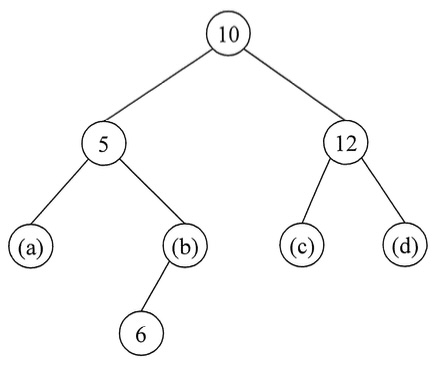東北大学 工学研究科 電気・情報系 2015年8月実施 問題4 情報基礎2
Author
祭音Myyura
Description
日本語版
下記の条件を満たす \(2\) 分木を、\(2\) 分探索木と呼ぶ、
- (条件) 各節点 \(u\) に対し、 \(u\) の要素を \(x\) とするとき、\(u\) の左部分木内の要素はすべて \(x\) より小さ く、\(u\) の右部分木内の要素はすべて \(x\) さより大きい。
各節点の要素とは重複しない整数であるとし、以下の問に答えよ。
(1) Fig. 4 は空の \(2\) 分探索木に \(10, 12, 11, 5, 8, 6, 2, 15\) を順に挿入して得られた \(2\) 分探索木 \(T\) を表している。要素 \((a),(b),(c),(d)\) の値を示せ.
(2) Fig. 4 の \(T\) から要素 \(10\) を持つ節点を削除し、得られる \(2\) 分探索木を示せ、なお、要素 \((a),(b),(c),(d)\) について、問(1)で示した具体的な値を用いてよい。
(3) ある \(2\) 分探索木から節点 \(p\) を削除するアルゴリズムを与えよ。
(4) ある \(2\) 分探索木のすべての要素を昇順に列挙する効率のよいアルゴリズムを示せ。
English Version
A binary tree that satisfies the following condition is called a binary search tree.
- (Condition) For each node \(u\), let \(x\) be the element of \(u\), each element stored in the left sub-tree of \(u\) is smaller than \(x\), and each element stored in the right sub-tree of \(u\) is greater than \(x\).
Assume that the element \(x\) of each node is an unique integer. Answer the following questions.
(1) Fig. 4 shows a binary search tree \(T\) obtained by inserting integers \(10, 12, 1, 5, 8, 6, 2, 15\) to an empty binary search tree in this order. Show the values of elements \((a), (b), (e)\) and \((d)\).
(2) Delete the node which stores the element \(10\) from \(T\) in Fig. 4, and show the obtained binary search tree. For the elements \((a), (b), (c)\) and \((d)\), you can use the concrete values you give in question (1).
(3) Give an algorithm to delete a node \(p\) from a binary search tree.
(4) Describe an efficient algorithm to enumerate all elements of a binary search tree in ascending order.

Kai
(1)
- \((a)\) 2
- \((b)\) 8
- \((c)\) 11
- \((d)\) 15
(2)
or
(3)
(4)
Hint: The inorder traversal of a BST gives the values of the nodes in sorted order.